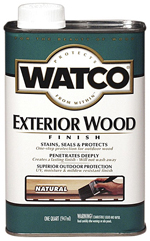
Recently my daughter and her husband purchased a home that will more easily accommodate their growing family. The entrance door is made from beautiful mahogany, varnished and painted twice. They would like the door refinished with a product that will last for several years and look great, without having to be stripped and refinished when it needs maintenance. They live in the South (Louisiana), and the door is facing south, protected from direct sunlight except for the bottom third of the door in the late afternoon. The varnish and paint on the bottom third of the door is crackling.
I have researched to find the best finish that has UV protection, mildewcide, is easily applied. I mainly looked at three products, Waterlox Marine Finish, Sikkens Cetol and Watco Exterior Wood Finish. Each of these products has pluses and minuses, which makes it all the more difficult to determine what we should use.
Why is there a sealer required before applying a marine finish? What would be some advantages of a varnish finish over a penetrating oil, and vice versa? Could you give us some advice that would help us determine what would give us the best results in this situation? – Katherine McCombs
Chris Marshall: Whether it’s a marine-grade spar varnish or otherwise, a film-forming finish such as varnish only truly seals the wood when the film is intact. As soon as it begins to crack or peel, it’s only going to get worse. And as you’ve witnessed on this door, UV light, summertime heat and moisture take their toll on a varnished exterior door. Unless the door is completely sheltered, in the long run there are probably more minuses than plusses for continuing with varnish. Personally, I’d opt for the penetrating oil route and just plan to reapply it every year or two to maintain protection and to prevent sunlight from fading the mahogany’s color to gray. That’s an easier alternative than stripping off the old, deteriorated varnish and reapplying it whenever that fails, which is what your family is going to need to do now before applying any new finish. Or — shudder at the thought — paint the outside of that mahogany door. Sure, no one wants to hide mahogany, but paint will outlast varnish and you won’t have to renew it annually like you will a penetrating finish.
Tim Inman: You are describing what many finishers would probably like to call the worst case scenario: outside service, high heat and humidity, lots of ultraviolet light, southern exposure, partial shade on part of the door in part of the seasons, and possibly one side painted and one side varnished. So, what to do?
Let me respond to your question about sealers first. There is nothing magic in a sealer. We use them to help get a better finish easier. Most sealers are either diluted coatings intended to provide deep and thorough initial penetration of the coating into the wood fibers, or a compatible material which can isolate (seal in) “what is below from what is above.” This through-and-through wetting with a sealer sets up a better base or foundation for the next coats to bond to. It just helps. Another thing sealers can help with is ease of use. Many times, sealers include some sanding aids to help get a really smooth surface quickly when scuff sanding after the sealer has dried. Talc or old-fashioned baby powder can be a source of one sanding aid, if you’re into home formulations. Sealers are to make it easier for you to have a superior finish when you’re done. You don’t have to use them, but they do help.
In your specific case, there are ultraviolet additives which can be purchased and applied as a “sealer” coat. This soaks the UV resistant material into the wood where it can help stop Old Sol (the sun) from damaging the wood fibers. The same UV material can also be added to the topcoats. Of course if you prefer not to be mixing things, buy a UV resistant varnish for your door. I’m not going to be brand-specific in my answer here, but rather I want to encourage you to understand that all the things you mention in your list of concerns do attack and destroy wood finishes — and wood. Ultimately, whatever you do, the sun will win. There is no finish that will last indefinitely in the UV world. Paint, because of the opaque pigments in them, will last longer than clear finishes like varnish. Varnish, because it is clear, allows UV light to penetrate into and through the finish – which makes it deteriorate faster.
Piano finishes are for pianos indoors, paint is for wood surfaces outside. You’ll have a longer lasting happiness if you can find a wood colored paint, and maybe even learn how to faux grain or glaze it so it looks like ‘clear’ wood. Varnish on wood is what makes sailors consider other hobbies after a few years.





